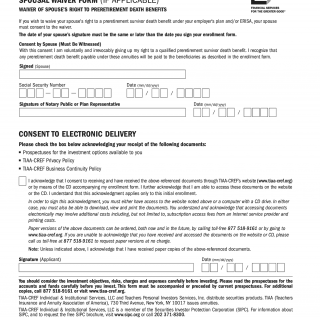TIAA Spouse Waiver Form
The TIAA Spouse Waiver Form is a legal document used to waive the spouse's right to a preretirement survivor death benefit under an employer's plan and/or ERISA (Employee Retirement Income Security Act). The form requires the consent of the spouse, which must be witnessed. Its purpose is to allow individuals to voluntarily and irrevocably give up their rights to a qualified preretirement survivor death benefit in favor of other beneficiaries.
The form consists of a section where the spouse provides their consent by signing, indicating that they understand and agree to waive their right to the preretirement survivor death benefit. This signature must be dated the same day or later than the date when the individual signing the enrollment form.
When filling out the form, it is crucial to ensure that both the employee and their spouse sign and date the document correctly. The spouse's signature indicates their voluntary and irrevocable waiver of the preretirement survivor death benefit.
No additional data or documents are explicitly mentioned as required for filling out the form. However, it is advisable to attach a copy of the enrollment form or any other relevant documentation that supports the spouse's consent and understanding of the waiver.
An example use case for this form would be when an employee wishes to designate specific beneficiaries other than their spouse to receive the preretirement survivor death benefit. By submitting the form with the spouse's consent, the individual ensures that the benefits will be paid out according to the beneficiaries specified in the enrollment form.
Strengths of the form include providing a clear mechanism for spouses to waive their rights in favor of other beneficiaries, allowing individuals greater control over the distribution of their retirement benefits. It ensures that the intentions of the participant are documented and legally binding.
Weaknesses or potential challenges may arise if the form is not completed accurately or if the spouse does not fully understand the implications of waiving their right to the preretirement survivor death benefit. In such cases, disputes or legal issues may arise in the future.
Opportunities for improvement could include providing clearer instructions on how to complete the form and offering additional resources or explanations to spouses to ensure they fully understand the implications of their consent.
As for threats, incorrect or fraudulent completion of the form could lead to unintended consequences, such as the disbursement of benefits to unintended beneficiaries or potential legal disputes among family members.
There are no specific examples or mentions of related or alternative forms provided in the description. However, analogous forms may exist in other retirement plans or financial institutions where similar rights and waivers need to be documented.
The form has significant implications for the future of the participants as it allows them to determine who will receive the preretirement survivor death benefit. By designating beneficiaries other than the spouse, individuals can ensure that their assets are distributed according to their wishes.
The completed form is typically submitted to the employer's HR department or retirement plan administrator for processing. It may be stored in the individual's personnel file or electronically within the company's record-keeping system, ensuring that it is readily accessible when needed.

